Important Questions of Heredity and Evolution Class 10 Science Chapter 9
Question 1.
All the variations in a species do not have equal chances of survival. Why? (Foreign 2014)
Answer:
All the variations do not have equal chances of survival in the environment in which they live. Depending on the nature of variations, different individuals would have different kinds of advantages. The organisms which are most adapted to the environment will survive.
Question 2.
“Only variations that confer an advantage to an individual organism will survive in a population.” Justify this statement. (Foreign 2011)
Answer:
Variations are the structural, functional or behavioural changes from the normal characters developed in the living organisms. Inheritable variations participate in evolution. According to Darwin, natural selection sorts out individuals with favourable variations. Such organism will survive, reproduce more and thus, will leave more progenies. Hence, useful variations get established in nature.
Question 3.
Assertion (A) : The sex of a child in human beings will be determined by the type of chromosome he/she inherits from the father.
Reason (R) : A child who inherits ‘X’ chromosome from his father would be a girl (XX), while a child who inherits a ‘Y’ chromosome from the father would be a boy (XY).
(a) Both (A) and (R) are true and (R) is the correct explanation of the assertion (A).
(b) Both (A) and (R) are true, but (R) is not the correct explanation of the assertion (A).
(c) (A) is true, but (R) is, false.
(d) (A) is false, but (R) is true. (2020)
Answer:
(a) Both (A) and (R) are true and (R) is the correct explanation of the assertion (A).
Question 4.
A Mendelian experiment consisted of breeding pea plants bearing violet flowers with pea plants bearing white flowers. What will be the result in F1 progeny? (2018)
Answer:
According to the Mendelian experiment, violet coloqr (VV) is a dominant trait while white colour (ww) is a recessive trait. Hence, the colour of the flower in F1 progeny will be violet (Vw).
Question 5.
Name the information source for making proteins in the cells. (Delhi 2014)
Answer:
Deoxyribonucleic acid (DNA) present in the chromosomes of cell nucleus is the information source for making proteins.
Question 6.
What is a gene? (AI 2014)
Answer:
A gene is a unit of DNA on a chromosome which governs the synthesis of particular protein that controls specific characteristics (or traits) of an organism.
Question 7.
What is heredity? (AI 2014)
Answer:
The inheritance of characters (or trails) from the parents to their offsprings is called heredity.
Question 8.
Why is the progeny always tall when a tall pea plant is crossed with a short pea plant? (Foreign 2014)
Answer:
When a tall pea plant is crossed with a short pea plant, the resultant progeny is always tall because tall is dominant trait and short is recessive trait. Therefore, dominant trait expresses itself in the progeny.
Question 9.
Write a difference between inherited traits and acquired traits giving one example of each. (Delhi 2013C)
Answer:
A trait (or characteristic) of an organism which is ‘not inherited’ but develops in response to the environment is called an acquired trait. For example, if a group of mice are normally bred, all their progeny will have tails. Now, if the tails of these mice are cut by surgery in each generation, tail-less mice will not be produced. This is so because removal of tail is an acquired character.
A trait (or characteristic) of an organism which is caused by a change in its genes (or DNA) is called an inherited trait. Inherited traits can be passed on to the progeny of the organism because they have produced changes in the genes (or DNA) of the organism. For example, skin colour in human beings.
Question 10.
(a) Why did Mendel carry out an experiment to study inheritance of two traits in garden pea?
(b) What were his findings with respect to inheritance of traits in F1 and F2 generation?
(c) State the ratio obtained in the F2 generation in the above mentioned experiment. (2020)
Answer:
(a) Mendel carried out crosses with two traits to see the interaction and basis of inheritance between them. In a dihybrid cross given by Mendel, it was observed that when two pairs of characters were considered each trait expressed independent of the other.
(b) For example, a cross between round yellow and wrinkled green parents.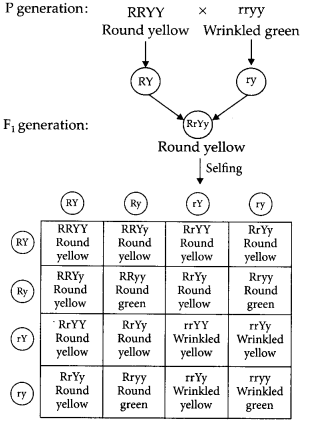
In F1 generation, all plants are with round yellow seeds. But in F2 generation, we find all types of plants : Round yellow, Round green, Wrinkled yellow, Wrinkled green.
F2 generation ratio : Round-yellow = 9 : Round- green = 3 : Colour of stem in F1 progeny Wrinkled- yellow = 3 : Wrinkled-green = 1
Question 11.
A green stemmed rose plant denoted by GG and a brown stemmed rose plant denoted by gg are allowed to undergo a cross with each other.
(a) List your observations regarding :
(i) Colour of stem in their F1 progeny
(ii) Percentage of brown stemmed plants in F2 progeny if plants are self pollinated.
(iii) Ratio of GG and Gg in the F2 progeny.
(b) Based on the findings of this cross, what conclusion can be drawn? (2020)
Answer:
(a) (i) Colour of stem in F1 progeny: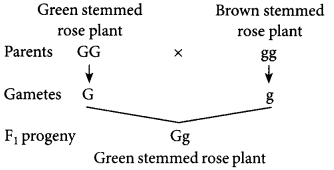
The colour in the F1 progeny is green stemmed as green stem colour is dominant.
(ii) F1 progeny on self pollination: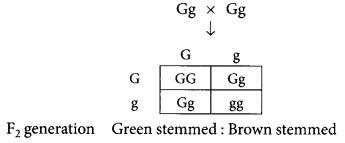
F2 generation Green stemmed: Brown stemmed
(iii) Ratio of GG and Gg in F2 progeny:
Genotype of F2 progeny – GG : Gg
1 : 2
(b) This is a monohybrid cross. This shows that out of two contrasting traits only one dominant trait appears in F1 generation and the trait which does not express is recessive. On selfing the F1 plants, both the traits appear in next generation but in a definite proportion.
Question 12.
(a) Why is the F1 progeny always of tall plants when a tall plant is crossed with a short pea plant?
(b) How is F2 progeny obtained by self-pollination of F1 progeny different from F1 progeny? Give reason for this observation.
(c) State a conclusion that can be drawn on the basis of this observation. (2020)
Answer:
(a) When a tall plant (TT) is crossed with a short tea plant (tt), only tall plants are obtained in F1 progeny. It is because out of two contrasting traits only one appears in the progeny of first generation. This means that the trait which appears in F1 generation is dominant and the trait which does not express is recessive. The character TT for tall plant is dominant, so all the plants are tall.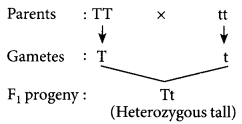
(b) On selfing F1 progeny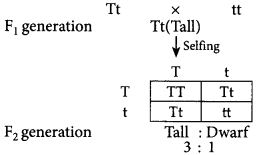
In F2 generation we obtained both tall and dwarf plants. Appearance of suppressed recessive trait in individuals of F2 generation in Mendelian cross indicates that characters of recessive traits are not lost. When the F1 generation plants were allowed to self-fertilise both the parental trait were expressed in definite proportion in F2 generation.
(c) Above observation shows that only one dominant allele is expressed. This is called law of dominance. In a heterozygous individual, two dissimilar alleles remain together and do not get mixed up. At the time of gamete formation, they separate so that each gamete receives only one allele is always pure. This is called “law of purity of gametes”.
Question 13.
Name the plant Mendel used for his experiment. What type of progeny was obtained by Mendel in F1 and F2 generations when he crossed the tall and short plants? Write the ratio he obtained in F2 generation plants. (Delhi 2019)
Answer:
Mendel selected garden pea (Pisum sativum) for his series of hybridisation experiments.
He first selected two pureline plants (tall plant having gene TT and short plant having gene tt) and then crossed such plants having contrasting characters. In the F1 generation, he observed that only one of the two contrasting character appeared, he called this character as dominant and the one which does not get expressed in F1 was called as recessive. He later selfed the F1 plants and observed that both the traits appear in next generation but in a definite proportion. This can be explained by the following cross :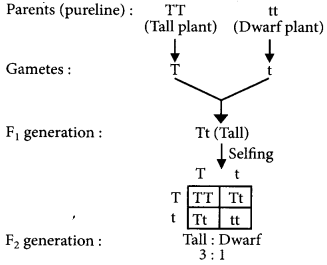
So, the plants of F1 generation will be all tall plants and after selfing the ratio of tall and dwarf plants that Mendel obtained in F2 generation plants is 3 : 1.
Question 14.
How did Mendels experiments show that different traits are inherited independently? Explain. (Delhi 2017)
Answer:
In a dihybrid cross given by Mendel, it was observed that when two pairs of traits or characters were considered, each trait expressed independent of the other. Thus, Mendel was able to propose the Law of Independent Assortment which says about independent inheritance of traits. This could be explained clearly from the given cross: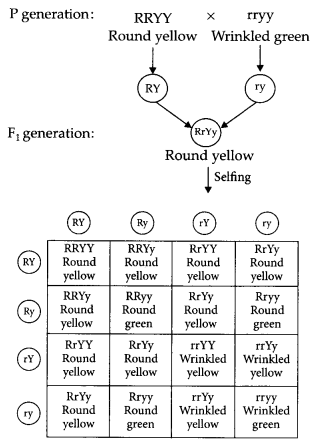
F2 generation ratio : Round-yellow = 9 : Round- green = 3: Wrinkled-yellow = 3: Wrinkled-green = 1
Question 15.
How did Mendel explain that it is possible that a trait is inherited but not expressed in an organism? (AI 2017)
Answer:
Mendel first selected two pure line plants. He then crossed such plants having contrasting characters. In the F1 generation, he observed that only one of the two contrasting character appeared, he called it dominant and the one which does not get expressed in F1 was recessive. He later selfed the F1 plants and observed that both the traits appear but in a definite proportion. It can be explained by the following cross :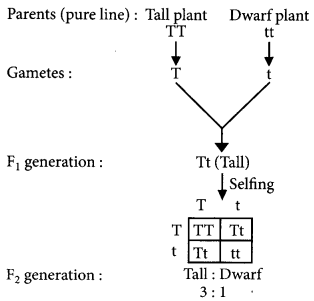
This is how Mendel explained that a trait may be inherited but not expressed in the plant.
Question 16.
In one of his experiments with pea plants Mendel observed that when a pure tall pea plant is crossed with a pure dwarf pea plant, in the first generation, F1 only tall plants appear.
(a) What happens to the traits of the dwarf plants in this case?
(b) When the F, generation plants were self- fertilised, he observed that in the plants of second generation, F2 both tall plants and dwarf plants were present. Why it happened? Explain briefly. (Delhi 2016)
Answer:
(a) Mendel’s monohybrid cross indicated that out of two contrasting traits only one appears in the progeny of first generation. This implies that the trait which appears in F1 generation is dominant and the trait which does not express is recessive. We can also say that gene controlling the dominant trait is dominant gene or allele and gene controlling the recessive trait is recessive gene or allele.
In F1 progeny although the dominant trait is expressed but genes for both dominant and recessive traits are present in a heterozygous condition. The recessive trait has a chance to express in next generation only if recessive genes come in homozygous condition. This can be illustrated by the given cross: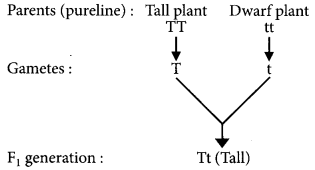
(b) Appearance of suppressed recessive trait in individuals of F2 generation in Mendelian cross indicates that the characters of recessive traits are not lost even when they are not expressed. When the F1 generation plants were allowed to self- fertilise, both the parental traits were expressed in definite proportion in F2 generation. This could be explained by the given cross by selfing the gametes obtained in F1 generation.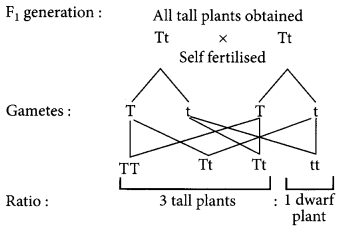
Question 17.
How did Mendel interpret his result to show that traits may be dominant or recessive? Describe briefly. (Delhi 2016)
Answer:
Mendel crossed the pea plant for two contrasting characters under consideration. The trait that expressed itself in F1 generation was dominant and the one not expressed in F1 generation was recessive. He later selfed the plants of F1 generation and recovered, both parental traits in a definite proportion in F2 generation. Mendel interpreted his results as, the trait that expressed itself in F1 was dominant and the one that reappeared in F2 generation was recessive. It can be demonstrated by the following cross: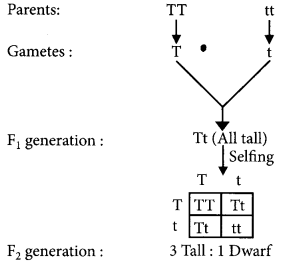
Question 18.
In a monohybrid cross between tall pea plants (TT) and short pea plants (tt) a scientist obtained only tall pea plants (Tt) in the F1 generation. However, on selfing the F1 generation pea plants, he obtained both tall and short plants in F2 generation. On the basis of above observations with other angiosperms also, can the scientist arrive at a law? If yes, explain the law. If not, give justification for your answer. (Delhi 2016)
Answer:
In the situation discussed in the question the scientist can arrive at two different laws, i.e., law of dominance and law of segregation (or law of purity of gametes). This can be explained with the help of following crosses: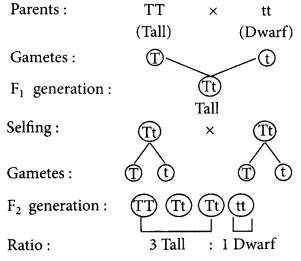
In F1 hybrid two dissimilar alleles are present for one character, i.e., height T is for tallness and t is for dwarfness, out of which only one allele called dominant allele expresses itself and the one which remains unexpressed is called recessive allele. This is called “law of dominance”.
Also the two dissimilar alleles that remain together in a heterozygous individual do not get mixed up and keep their distinct identity. Hence, at the time of gamete formation they separate so that each gamete receives only one allele and is always pure which enables reappearance of recessive trait in F2 progenies when the two recessive alleles come together. This is called “law of purity of gametes.”
Question 19.
How do Mendel’s experiment show that traits are inherited independently? (AI 2016)
Answer:
Refer to answer 14.
Question 20.
With the help of an example justify the following statement: “A trait may be inherited, but may not be expressed.” (AI 2016)
Answer:
A trait may be inherited but may not be expressed, this could be explained by the given example. When a tall pea plant was crossed with a dwarf pea plant, then F1 generation plants were all tall. When F1 plants were selfed, then F2 generation plants were both tall and dwarf. This shows that the F1 plants had inherited both the parental traits but did not express dwarfness or recessive trait in the presence of the trait for tallness or dominant trait. This could be explained by the given cross :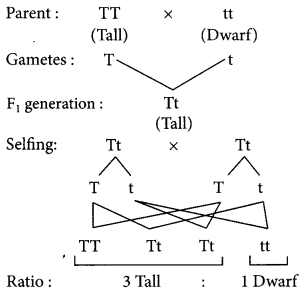
Question 21.
List two differences in tabular form between dominant trait and recessive traits. What percentage/proportion of the plants in the F2 generation/progeny were round, in Mendel’s cross between round and wrinkled pea plants? (Foreign 2016)
Answer:
Differences between dominant traits and recessive trait are given below:
| Dominant trait | Recessive trait |
| (i) It is the trait controlled by dominant allele. | It is the trait controlled by recessive allele. |
| (ii) It is the trait which is expressed in F1 generation. | It is the trait which remains suppressed in F1 generation and appears in F2 generation. |
Out of total 4 genotypes possible in F2 generation 31 genotypes result in phenotypic expression of round seeds. So, the percentage of plants with round seeds will be 75%. This can be illustrated as follows: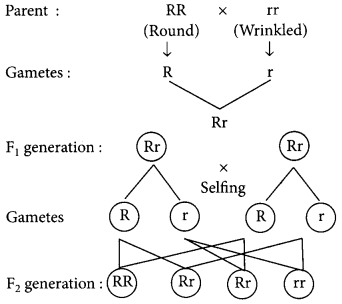
Question 22.
Explain Mendel’s experiment with peas on inheritance of characters considering only one visible contrasting character. (Foreign 2016, 2014)
Answer:
Mendel crossed a pure tall pea plant with pure dwarf pea plant. All the plants obtained in F1 generation were tall. When Mendel selfed plants from F1 generation then he obtained both tall and dwarf plants in F2 generation in the ratio of 3 : 1. This can be illustrated as follows :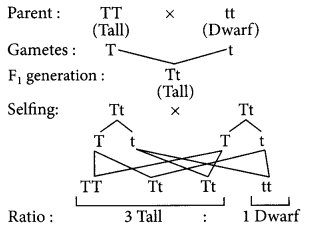
This explains that for each pair of contrasting characters there are two alleles. The trait which is expressed in F1 is dominant trait and is controlled by dominant allele and the trait which remains unexpressed in F1 is the recessive trait and is controlled by recessive gene. When both the contrasting alleles are present together in F1 individuals, no mixing of alleles occurs and they again segregate at the time of gamete formation Therefore, when the recessive alleles come together they result in reappearance of recessive trait in F2 generation.
Question 23.
“It is a matter of chance whether a couple will have a male or a female child.” Justify this statement by drawing a flow chart. (Foreign 2015)
Answer:
Sex is determined at the time of fertilisation when male and female gametes fuse. Male produces two types of gametes, i.e., having X or Y chromosome and female produces same type of gametes containing X chromosomes. The sex of the child is determined at the time of fertilisation when male and female gametes fuse to form zygote.
If a sperm (male gamete) carrying X chromosome fertilises an egg or ovum (female gamete) carrying X chromosome, then the offspring will be a girl (female). This is because the offspring will have XX combination of sex chromosomes.
If a sperm (male gamete) carrying Y chromosome fertilises an egg or ovum (female gamete) which has X chromosome, then the offspring will be a boy (male). This is because the offspring will have XY combination of sex chromosomes.
Therefore, there are 50% chance of a male child and 50% chance of a female child.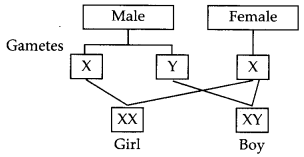
Question 24.
“It is possible that a trait is inherited but may not be expressed.” Give a suitable example to justify this statement. (Foreign 2015)
Answer:
Refer to answer 20.
Question 25.
A cross was made between pure breeding pea plants, one with round and green seeds and the other with wrinkled and yellow seeds.
(a) Write the phenotype of F1 progeny. Give reason for your answer.
(b) Write the different types of F2 progeny obtained along with their ratio when F1 progeny was selfed. (Delhi 2014, Delhi 2013C)
Answer:
(a) The given cross was made between pure breeding pea plants, one with round and green seeds and the other with wrinkled and yellow seeds.
Yellow seed colour and round seed shape is dominant over green seed colour and wrinkled seed shape. In F1 generation, dominant traits express itself, whereas recessive traits get suppressed.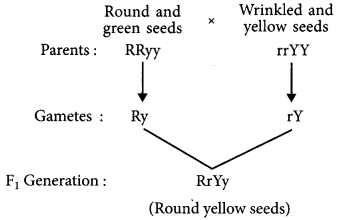
Therefore, the phenotype of F1 progeny is round and yellow.
(b) The different types of F2 progeny obtained along with their ratio when F1 progeny was selfed could be illustrated by the given cross.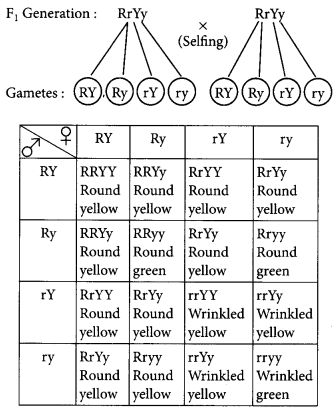
Phenotypic ratio : 9 : 3 : 3 : 1
Round yellow seeds – 9 ; Round green seeds – 3;
Wrinkled yellow seeds – 3; Wrinkled green seeds – 1
Question 26.
(a) Mendel crossed tall pea plants with dwarf pea plants in his experiment. Write his observations giving reasons on the F1 and F2 generations.
(b) List any two contrasting characters other than height that Mendel used in his experiments in pea plants. (Delhi 2014)
Answer:
(a) The possible cross of Mendel’s experiment is: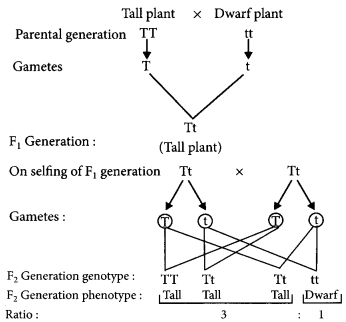
Hence, tall (T) is dominant whereas dwarf (t) is recessive. In F1 generation, only dominant trait expresses itself, whereas recessive trait gets suppressed.
In F2 generation, both traits, i.e., dominant and recessive express themselves. In this way, Mendels experiment showed that the traits (tall and dwarf) are inherited independently.
(b) The two contrasting characters other than height that Mendel used in his experiment in pea plants are round/wrinkled seeds and violet/white flowers.
Question 27.
“A trait may be inherited, but may not be expressed”. Justify this statement with the help of a suitable example. (AI 2014)
Answer:
Refer to answer 20.
Question 28.
“The sex of a newborn child is a matter of chance and none of the parents may be considered responsible for it”. Justify this statement with the help of flow chart showing determination of sex of a new born. (Delhi 2013)
Answer:
Refer to answer 23.
Question 29.
A blue colour flower plant denoted by BB is cross-bred with that of white colour flower plant denoted by bb.
(a) State the colour of flower you would expect in their F1 generation plants.
(b) What must be the percentage of white flower plants in F2 generation if flowers of F1 plants are self-pollinated?
(c) State the expected ratio of the genotypes BB and Bb in the F2 progeny. (Delhi 2012)
Answer:
(a) The colour of the flower in F1 generation will be blue.
(b) If the flowers of F1 generation are self pollinated, then the percentage of white flowers in F2 generation must be 25%.
(c) The expected ratio of the genotypes BB and Bb in the F2 generation progeny is 1 : 2.
The above results could be depicted by the given cross: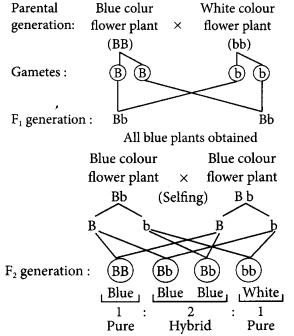
Question 30.
If we cross pure-breed tall (dominant) pea plant with pure-breed dwarf (recessive) pea plant we will get pea plants of F1 generation.
If we now self-cross the pea plant of F1 generation, then we obtain pea plants of F2 generation.
(a) What do the plants of F1 generation look like?
(b) State the ratio of tall plants to dwarf plants in F2 generation.
(c) State the type of plants not found in F1 generation but appeared in F2 generation, mentioning the reason for the same. (AI 2012)
Answer:
(a) The plants of F1 generation will be all tall plants.
(b) The ratio of tall plants to dwarf plants in F2 generation is 3 : 1.
(c) Dwarf plants are not found in F1 generation but appeared in F2 general ion. This is so because in F1 generation only dominant trait (tall) expresses itself and recessive trait (dwarf) gets suppressed. The dwarf plants appeared in F2 generation, because the traits whether dominant or recessive are independently inherited. In others words, a single copy of (T) is enough to make the plant tall, while both copies have to be (t) for the plant to be dwarf.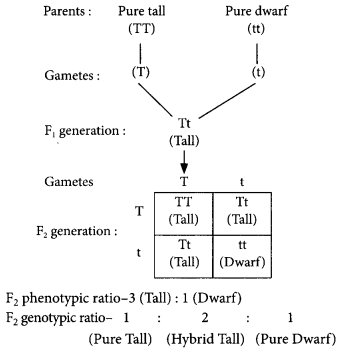
Question 31.
With the help of a flow chart explain in brief how the sex of a newborn is genetically determined in human beings. Which of the two parents, the mother or the father, is responsible for determination of sex of a child? (Foreign 2012)
Answer:
Refer to answer 23.
Question 32.
How is the sex of the child fixed during the fertilisation, step in human beings? Explain. (Foreign 2011)
Answer:
Human beings have 23 pairs chromosomes (22 pairs of autosomes +1 pair of sex chromosome). A male has one X chromosome and one Y chromosome whereas a female has two X chromosomes. Sex of a child depends on the two conditions which takes place during fertilisation. The two conditions are given below:
- If a sperm carrying X chromosome fertilises an ovum which carries X chromosome, then the child born will be girl.
- If a sperm carrying Y chromosome fertilises an ovum which carries X chromosome, then the child born will be a boy.
Question 33.
How do Mendels experiments show that
(a) traits may be dominant or recessive?
(b) inheritance of two traits is independent of each other? (Delhi 2017)
Answer:
(a) Mendel first crossed pure-bred tall pea plants with pure-bred dwarf pea plants and found that only tall pea plants were produced in the first generation (F1). He then self crossed the tall pea plants of the F1 generation and found that tall plants and dwarf plants were obtained in the second generation or (F2) in the ratio of 3 : 1. Mendel said that the trait of dwarfness of one of the parent pea plant had not been lost, it was merely concealed or suppressed in the first generation to re-emerge in the second generation. He called the suppressed trait of ‘dwarfness as ‘recessive trait’ and the expressed trait of ‘tallness’ as the ‘dominant trait’. In this way, Mendel’s experiments with tall and dwarf pea plants showed that the traits may be dominant or recessive.
Hence this could be explained by the given cross :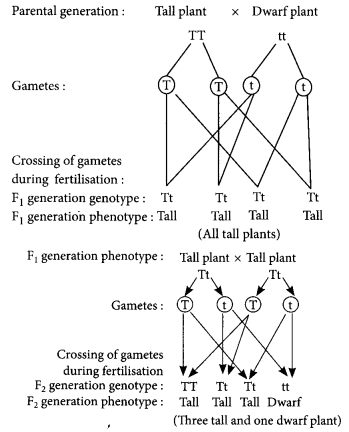
(b) Mendel observed two combinations of characteristics in seeds, round-yellow and wrinkled-green, and two new combinations of characteristics had appeared in the F2 generation, round-green and wrinkled- yellow. According to Mendel’s second law of inheritance more than one pair of traits are considered in a cross simultaneously, the factors responsible for each pair of trait are distributed independently to the gametes.
The cross given below showing dihybrid cross explains that the inheritance of two traits is independent of each other.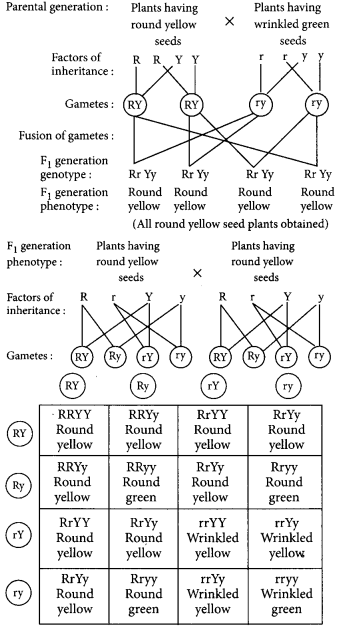
Question 34.
(a) Why did Mendel choose garden pea for his experiments ? Write two reasons.
(b) List two contrasting visible characters of garden pea Mendel used for his experiment.
(c) Explain in brief how Mendel interpreted his results to show that the traits may be dominant or recessive. (Foreign 2016)
Answer:
(a) Mendel choose garden pea for his experiments because:
(i) It was easy to grow and it shows some clear contrasting traits like some pea plants are tall whereas others are dwarf.
(ii) Pea plants are self pollinating and many generation of pea plants can be produced in comparatively less time.
(b) The contrasting characters of garden pea plant studied by Mendel are:
| Character | Plant | |
| Dominant | Recessive | |
| 1. Plant height | Tall | Yellow |
| 2. Colour of the seed | Dwarf | Green |
(c) Refer to answer 17.
Question 35.
Give the respective scientific terms used for studying:
(a) the mechanism by which variations are created and inherited and
(b) the development of new type of organisms from the existing ones. (Delhi 2014)
Answer:
(a) Heredity is the mechanism by which variations are created and inherited.
(b) Evolution is the process in which development of new type of organisms takes place from the existing ones.
Question 36.
Write the contribution of Charles Darwin in the field of evolution. (Delhi 2014)
Answer:
‘Lhe contribution of Charles Darwin in the field of evolution is that only the organism which can adapt; to the changing environmental conditions can survive and he also stated that the natural selection is a process which plays an important role in evolution of plants and animals by selecting the organisms with traits favourable to the environment.
Question 37.
Why do mice whose tails were surgically removed just after birth for generations, continue to produce mice with tails? (Foreign 2014)
Answer:
A group of mice are normally bred and all their progeny possess tail. Now, if the tails of these mice are surgically removed in each generation, tail¬less mice will not be produced. This is so because removal of tail during the life cycle of mice is an acquired character which is not transferred to future generations. The removal of the tail cannot change the genes of the germ cells of the mice.
Question 38.
List two differences between acquired traits and inherited traits by giving an example of each. (Delhi 2019)
Answer:
Differences between the inherited traits and acquired traits are as follows :
| Inherited traits | Acquired traits |
| (i) These are passed from the parent to offspring. | These are developed during the life of an individual. |
| (ii) These are genetic variations. | These are somatic variations. |
| (iii) These develop due to crossing over phenomenon and mutations. | These develop due to use and disuse of organs and direct effect of environment. |
| (iv) These are passed on from one generation to the other. | These traits die with the death of the individual. |
| (v) Example: Skin colour, eye colour, form of hair, polydactyly (extra fingers), free and attached ear lobes, blood groups of human beings. | Example: If a group of mice are normally bred, all their progenies will have tails. Now, if the tails of these mice are removed surgically in each generation, tailless mice will not be produced. It is so because removal of tail is an acquired character and it will not bring change in the genes of the germ cells of the mice. |
Question 39.
Define genetics. Why is decrease in the number of surviving tigers a cause of concern from the point of view of genetics? Explain briefly. (AI 2019)
Answer:
Genetics is the branch of biology that deals with the study of heredity and variations. The term genetics’ was coined by William Bateson in 1906. When a population is small, the number and scope of variations is limited and hence diversity and traits are reduced. Small numbers of surviving tigers are a cause of worry from the point of genetics because of the following reasons:
- Their loss would cause a loss of gene pool, i.e., many genes will be eliminated from a gene pool.
- Tigers are surviving in limited numbers, so if some natural calamity kills these small population of tigers, they will suddenly become extinct as per genetic drift phenomenon,
- A disease may wipe out the leftover population, if the entire population is susceptible to the disease. This can cause sudden extinction of the tiger species and loss of their genes forever, thus, adversely affecting the diversity of nature.
Question 40.
Distinguish between the acquired traits and the, inherited traits in tabular form, giving one example for each. (Delhi 2017)
Answer:
Refer to answer 38.
Question 41.
With the help of two suitable examples, explain why certain experiences and traits earned by people during their lifetime are not passed on to their next generations. When can such traits be passed on? (AI 2017)
Answer:
Certain experiences and traits earned by people during their lifetime are not passed on to their next generations because all these characters are acquired by the man during his lifetime. The man is not born with these traits and he cannot pass on these traits to his children. These could be better explained by the given examples:
(i) Child of a very good swimmer may not know how to swim. This is so because the technique of swimming is not inherited from parents but it is learnt by the person himself or herself.
(ii) A person may have a scar on the face from a cut he got in an accident. This is also an example of acquired trait which cannot be passed to the next generation.
Traits can be passed on to future generations in which changes have occurred in the genes present in the reproductive cells of the parent organisms. These traits or characters are known as inherited traits.
Question 42.
List three distinguishing features, in tabular form, between acquired traits and the inherited traits. (Delhi 2016)
Answer:
Refer to answer 38.
Question 43.
“We cannot pass on to our progeny the experience and qualifications earned during our lifetime.” Justify the statement giving reason and examples. (Delhi 2015)
Answer:
Refer to answer 41.
Question 44.
List in tabular form, two distinguishing features between the acquired traits and the inherited traits with one example of each. (Delhi 2015, AI 2012)
Answer:
Refer to answer 38.
Question 45.
Distinguish between inherited and acquired traits by giving one example of each. Give reason why the traits acquired during the lifetime of an individual are not inherited. (Foreign 2014)
Answer:
Refer to answers 38 and 41.
Question 46.
With the help of suitable examples, explain why certain traits cannot be passed on to the next generation? What are such traits called? (AI 2014)
Answer:
Refer to answer 41.
Question 47.
Tabulate two distinguishing features between acquired traits and inherited traits with one example of each. (Delhi 2013)
Answer:
Refer to answer 38.
Question 48.
“An individual cannot pass on to its progeny the experiences of its life-time”. Justify the statement with the help of an example and also give reason for the same. (Foreign 2012)
Answer:
If we breed a group of mice, all the progeny of mice will have tails just like their parents. Now, if we remove the tails surgically and again breed them, we still get new mice with tails. This is because cutting the tails of mice does not change the genes of their reproductive cells (or gametes). And since the acquired trait of‘cut tails’ does not bring about a change in the genes of mice, this trait cannot be passed on to their next generations. From this we conclude that the experiences acquired by an individual during his lifetime (called acquired traits) cannot be passed on to its progeny, and hence cannot lead to evolution because they are not caused by the change in genes.
Question 49.
Describe any three ways in which individuals with a particular trait may increase in population. (AI 2011)
Answer:
Three ways in which individuals with a particular trait may increase in population are:
(i) Genetic drift : It is the random change in gene frequency occurring by chance fluctuations. In this phenomenon, an event may increase the frequency of a particular trait having little adaptive value and survival advantage.
(ii) Natural selection : It is the phenomenon wherein nature selects traits favourable to the species in the environment. Thus, a particular trait selected by the nature increases in number.
(iii) Geographical isolation : Interbreeding populations are geographically isolated by barriers such as mountain ranges, rivers and sea. This geographical isolation leads to reproductive isolation and thus there is no gene flow between separated groups of population and therefore, population with particular character increases.
Question 50.
(a) What is the law of dominance of traits? Explain with an example.
(b) Why are the traits acquired during the life time of an individual not inherited? Explain. (2020)
Answer:
(a) Mendel’s law of dominance states that for a particular trait one gene is usually expressed over the other. The dominant allele expresses itself and the one which remains unexpressed is called recessive allele. This is called “law of dominance”. E.g., for height, there are two alleles, T for tallness and t for dwarfness.
(b) Refer to answer 41.
Question 51.
What is speciation?
Answer:
The process by which new species develop from the existing species is known as speciation.
Question 52.
What is speciation? Explain in brief the role of natural selection and genetic drift in this process. (Foreign 2016)
Answer:
‘Hie process by which new species develop from the existing species is known as speciation. Both natural selection and genetic drift play a very important role in speciation. By natural selection traits favourable to the species in the given environment are selected by the nature.
Example, beetles develop colour variation during reproduction. Consequently, in the progeny, one beetle develops green body colour instead of normal red colour. This beetle can inherit this variation in colour on to its progeny so that all its offspring are green in colour. Crows cannot easily locate green-coloured beetles on the green leaves of bushes and continue to eat red beetles which are easily located on green leaves. As a result, in population of green beetles increases in each generation.
Genetic drift is the elimination of the genes of certain traits from the small population when a section of population dies of natural calamity or migrates to other region. It alters the gene frequency of the remaining population.
Suppose in sexually reproducing red beetle population, a colour variation arises wherein one beetle develops blue body colour instead of red. This beetle can also pass this colour variation to its progeny so that all its offspring are blue coloured beetles. As the population of beetles expand, initially there would be few blue coloured beetles among the majority of red coloured beetles. At this point, an elephant comes by and stamps on the bushes where the beetles live. Consequently, most of the beetles get killed. By chance, most of the survived beetles are of blue colour. This population again slowly multiply and will contain mostly blue coloured beetles over a period of time. Survival of more blue beetles in the population changed the coloured characteristic from normal red to blue over a period of time. In small population, accidents can change the frequency of some genes in a population, even if it does not give any survival advantage to the possessors.
Question 53.
What is speciation? List four factors responsible for speciation. (Delhi 2015)
Answer:
The process by which new species develop from the existing species is known as speciation. The four factors responsible for speciation are:
- Geographical isolation of a population leads to reproductive isolation and hence speciation.
- Genetic drift leads to the formation of new species by causing drastic changes in the frequencies of particular gene by chance alone.
- Natural selection wherein nature in the wild selects traits favourable to the species in the given environment.
- Random mating resulting in genetic variations in genotype frequencies within the population.
Question 54.
Explain the following:
(a) Speciation
(b) Natural selection. (Al 2015, Delhi 2011)
Answer:
(a) Speciation : Origin of new species from existing one due to reproductive isolation of a part of its population is called speciation.
Suppose a large population of beetle living in an area gets split into two sub populations due to geographical barriers like river, mountain, sea, etc. Then members of these sub-populations will not be able to interbreed. Hence, there will be no gene flow between the members of these populations. After few generations, genetic drift will accumulate different variations in each of the two geographically separated sub-populations. Natural selection may also operate simultaneously in a different way in these geographically isolated sub-populations. This makes geographically isolated sub-populations to become more and more different from each other and ultimately reproductive isolation occurs between individuals of these groups and they transform into new species.
(b) Natural selection is the phenomenon wherein nature, in the wild, selects traits favourable to the species in its environment.
Also refer to answer 52.
Question 55.
List three main factors responsible for the speciation and briefly describe each one of them. (AI 2014)
Answer:
Speciation is the process by which new species develop from the existing species.
The three important factors responsible for the speciation are:
(i) Geographical isolation of a population caused by various types of barriers such as mountain ranges, rivers and sea. Geographical isolation is the major factor in the speciation of sexually reproducing animals because it causes reproductive isolation and interrupts the flow of genes between their isolated populations through the gametes.
(ii) Genetic drift is the elimination of the genes of certain traits from the small population when a section of population dies of natural calamity or migrates to other region. It alters the gene frequency of the remaining population.
(iii) Variations introduced by random mating and hybridisation. Random fusion of gametes adds new alleles and it result in formation of new species.
Question 56.
List three main factors responsible for the rise of a new species giving a brief description about each. (Foreign 2014)
Answer:
Refer to answer 55.
Question 57.
What is meant by the term speciation? List four factors which could lead to speciation. (Delhi 2012)
Answer:
Refer to answer 53.
Question 58.
(a) Classify the following as homologous or analogous pairs:
(i) Broccoli and cabbage
(ii) Ginger and radish
(iii) Forelimbs of birds and lizard
(iv) Wings of a bat and wings of a bird
(b) State the main feature that categorises a given pair of organs as homologous or analogous. (2020)
Answer:
(a) (i) Broccoli and cabbage – Homologous organs
(ii) Ginger and radish – Analogous organs
(iii) Forelimbs of birds and lizard – Homologous organs
(iv) Wings of bat and wings of a bird – Analogous organs
(b) Homologous organs have the same fundamental structure but different in function, while analogous organs have different internal structure but similar functions.
Question 59.
“During the course of evolution, organs or features may be adapted for new functions”. Explain this fact by choosing an appropriate example. (2020)
Answer:
Evolution is the sequence of gradual changes from simple life forms to complex life form. During the evolution process, many organs are adapted for new functions.
The organs which perform different functions in different species but have similar basic structure and similar embryonic origin are called homologous organs. Homologous structures are a result of divergent evolution. Homology indicates common ancestry.
For example, the forelimbs of a frog, a lizard, a bird and a human being show similarity in basic structure. However, these organs perform entirely different functions.
The given figures showing homologous organs :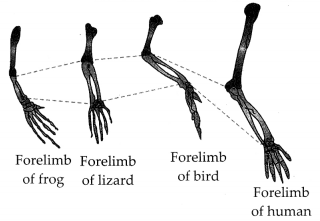
The forelimbs of a frog help the animal to prop up the front end of the body at rest, and also act as shock absorbers when the animal lands on the ground after a leap; the forelimbs of a lizard are modified for creeping movements; the forelimbs of a bird are modified for flying purposes, while the forelimbs of a human being are used for grasping. The basio similarity in the forelimbs of these different vertebrates indicates that all these vertebrates had common ancestry, i.e., they have evolved from a common ancestor who had ‘five digited’ or ‘pentadactyl’ limbs (basic plan of limbs).
This means that these vertebrates have modified according to the special needs of the subsequent generations during the course of evolution.
Question 60.
Explain with the help of an example each, how the following provide evidences in favour of evolution:
(a) Homologous organs
(b) Analogous organs
(c) Fossils (Delhi 2017, AI 2015, Delhi 2011)
Answer:
(a) Homologous organs perform different functions in different species but have similar basic structure and similar embryonic origin. For example, forelimbs of a frog, lizard, bird and human being show similarity in basic structure. However, these organs perform entirely different functions but the basic similarity in the forelimbs of these different vertebrates indicates common ancestry. This means that these vertebrates have modified according to the special needs of the subsequent generations during the course of evolution.
(b) Analogous organs are different in fundamental structure and embryonic origin but have similar appearance and perform similar functions. For example, the wings of an insect and a bird have different structures but they perform the same function of flying. The presence of these organs indicates that they are not derived from common ancestors but they can still evolve to perform similar functions to survive, flourish and keep on evolving in the prevailing environment. This provides a mechanism for evolution.
(c) Fossils are the remains or impressions of the dead animals and plants that lived in the remote past. The fossils provide evidence for evolution. For example, a fossil bird called Archaeopteryx have characters of both reptiles and birds. It had feathers, fused bones and beak which are exclusive characters of birds and had teeth in the jaws, claws on fingers, a long tail, etc like reptiles. Thus, Archaeopteryx is a connecting link between the reptiles and birds, and hence suggests that the birds have evolved from the reptiles through the process of continuous evolution.
Question 61.
“Evolution and classification of organisms are interlinked”. Give reasons to justify this statement. (AI 2017)
Answer:
Evolution is the process by which newer types of organisms are developed from the pre-existing ones through modifications. Classification is the arrangement of organisms into a series of groups based on physiological, biological, anatomical or other relationships. All systems of classification are hierarchial. The more closely two species are related, the more recently they have a common ancestor. Classification of organisms necessarily involves organising them in different groups, based on the similarities and differences of characteristics. It helps in the recognisation of the basic arrangement of a hierarchical structure among diverse species. It facilitates studies or research of wide variety associated with organisms effortlessly. Thus, classification of species is infact a reflection of their evolutionary relationship or we can say that evolution and classification are interlinked.
Question 62.
“Two areas of study namely evolution’ and classification are interlinked”. Justify this statement. (AI 2016)
Answer:
Refer to answer 61.
Question 63.
List three factors that provide evidences in favour of evolution in organisms and state the role of each in brief. (Foreign 2016)
Answer:
Some of the important sources which provide evidences for evolution are homologous organs, analogous organs and fossils.
Also refer to answer 60.
Question 64.
(a) Planaria, insects, octopus and vertebrates all have eyes. Can we group eyes of these animals together to establish a common evolutionary origin? Justify your answer.
(b) “Birds have evolved from reptiles”. State evidence to prove the statement. (Delhi 2015)
Answer:
(a) Planaria, insects, octopus and vertebrates cannot be grouped together on the basis of eye. Eyes of insects, octopus, Planaria and vertebrates are analogous organs which have developed over generation as an adaptation for similar function. They represent convergent evolution where distantly related groups develop similar functional structure as an adaptation for same function.
(b) Fossil bird Archaeopteryx had features like feathers, fused bones, beak which are the characteristic features of birds. It also had some features of reptiles, like, teeth in jaws, claws on free fingers, a long tail, etc. Thus, it represents a connecting link between reptiles and birds. This example provides a clue that birds have evolved from reptiles.
Question 65.
(a) Cite the evidence on the basis of which it is concluded that birds have evolved from reptiles.
(b) Insects, octopus, Planaria and vertebrates also possess eyes. Can these animals be grouped together on the basis of the eyes they possess. Why or why not ? Give reason to justify your answer. (Foreign 2015)
Answer:
(a) Refer to answer 64(b).
(b) Refer to answer 64(a).
Question 66.
(a) Give the evidence that the birds have evolved from reptiles.
(b) Insects, octopus, Planaria and vertebrates possess eyes. Can we group these animals together on the basis of eyes that they possess? Justify your answer giving reason. (Delhi 2014)
Answer:
(a) Refer to answer 64(b).
(b) Refer to answer 64(a).
Question 67.
What are fossils? How do they help in the study of evolution? (Delhi 2013C, AI 2011)
Answer:
Refer to answer 60(c).
Question 68.
Distinguish between homologous organs and analogous organs. In which category would you place wings of a bird and wings of a bat? Justify your answer giving a suitable reason. (Delhi 2012)
Answer:
Those organs which have the same basic structure and similar embryonic origin but different functions are called as homologous organs.
These organs follow same basic plant of organisation during development, but in adults got modified to perform different function as an adaptation to different environments. Those organs which have different basic structure and embryonic origin but perform similar functions are called analogous organs.
The wings of bird and wings of bat are analogous organs because the basic structure or design of the wings of bird and bat are different but they perform the similar function of flying.
Question 69.
How are fossils formed? Describe, in brief, two methods of determining the age of fossils. (AI 2012)
Answer:
When organisms like plants or animals die, their bodies get decomposed by the action of microorganisms in the presence of oxygen, moisture, etc. Sometimes the conditions in the environment are such (like absence of oxygen, moisture, etc.), which do not let the body of the organism to get decompose completely. It is the body (or body part) of an organism which we get as fossil on digging the earth. In many cases the soft parts of the organisms get decomposed and we get skeleton of hard parts (like teeth, bones, etc.) as fossil. Even the soft parts of the plants and animals (which usually decompose quickly) are sometimes preserved as fossils in the form of their impressions inside the rocks. For example, if a dead leaf gets caught in mud, it will not decompose quickly. The mud around the leaf will set around it as a mould,’gradually harden to form a rock and retain the impression of the leaf. This forms a leaf fossil which can be dug out from the earth a after a long time period.
The age of fossils can be determined in two ways as given below:
(i) By the relative method: When we dig into the earth, we find fossils at different depths. The fossils which we find in layers closer to the surface of the earth are more recent and those fossils which are found in deeper layers are older; whereas the fossils found in the deepest layers of earth are the oldest ones.
(ii) Carbon dating method: When a living object dies and forms fossil, its carbon-14 radioactivity goes on decreasing gradually. By this method, the age of fossils is found by comparing the carbon-14 radioactivity left in fossils with the carbon-14 radioactivity present in living objects today.
Question 70.
(a) We see eyes in Planaria, insects, octopus and vertebrates. Can eyes be grouped together in case of the above-mentioned animals to establish a common evolutionary origin? Why?
(b) State one evidence to prove that birds have evolved from reptiles. (Foreign 2012)
Answer:
(a) Refer to answer 64 (a).
(b) Refer to answer 64 (b).
Question 71.
Explain how evolutionary relationship can be traced by the study of homologous organs. (Foreign 2011)
Answer:
Homologous organs provide morphological and anatomical evidences of evolution. There are number of organs in different groups of animals or plants which have similar basic design but are used for different purposes. These are termed as homologous organs. For example, the forelimbs of frog, lizard, bird and human beings show similarity in basic structure. The basic similarity of forelimbs of these different vertebrates indicates that all these have evolved from a common ancestor who had five digited or pentadactyle limbs which became modified according to the special needs of subsequent generations during the course of evolution. Hence, homologous organs depict divergent evolution or adaptive radiation.
Question 72.
(a) How do the following provide evidences in favour of evolution in organisms? Explain with an example for each.
(i) Homologous organs
(ii) Analogous organs
(iii) Fossils
(b) Explain two methods to determine the age of fossils. (AI 2019)
Answer:
(a) Refer to answer 60.
(b) Refer to answer 69.
Question 73.
Define evolution. How does it occur?
Describe how fossils provide us evidence in support of evolution. (AI 2016)
Answer:
Evolution is the sequence of gradual changes, from simple life forms to complex life form, i.e., from primitive organisms that lived over millions of years ago to new organisms that exist today. Evolution occurs by changes, improvement and modification of simple life forms. Fossils are the remains or impressions of organisms that lived in the remote past. Fossils provide the evidence that the present animal have originated from previously existing ones through the process of continuous evolution. Fossils can be used to reconstruct evolutionary history of an organism. The distribution pattern of fossils shows that the ancient fossils present in the bottom rocks are simple, while the most recent fossils found in the upper strata are more highly evolved. It means fossils form and become more and more complex as we proceed from earliest to recent rocks. It gives us an idea of time in history when different species were formed or became extinct. Thus, fossils provide us evidences in support of evolution.
Question 74.
What are fossils? How are they formed? List two methods of determining the age of fossils. Explain in brief the importance of fossils in deciding the evolutionary relationships. (Foreign 2016)
Answer:
Refer to answers 60(c) and 69.
Question 75.
Define the term evolution. “Evolution cannot be equated with progress”. Justify this statement. (2020)
Answer:
Evolution is the sequence of gradual changes which take place in the primitive organisms over millions of years in which new species are produced.
Evolution should not be equated with progress because there is no real progress in the concept of evolution. Evolution is just the production of diversity of life forms and shaping of this diversity by the environmental selection. The only progress in evolution appears to be that more and more complex body designs of organisms have emerged over the ages. This will become clear from the following examples. When a new species is formed, it is not necessary that the old species will disappear or get eliminated from earth.
It will all depend on the environment. Also it is not as if the newly formed species are in any way better than the older ones. It is simply that genetic drift and natural selection processes have combined to form a population having different body design which cannot interbreed with the older population. It is a common belief that chimpanzees are the ancestors of human beings. It is, however, not true that human beings have evolved from chimpanzees. Actually, both chimpanzees and human beings had a common ancestor long time ago. The two offsprings of that ancestor evolved in their own separated ways to form the modern day chimpanzees and human beings.










